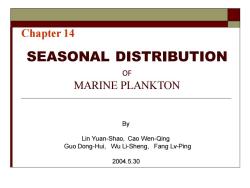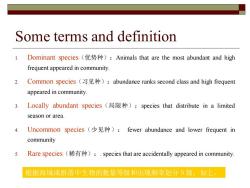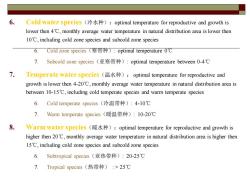厦门大学:《海洋浮游生物学》课程教学资源(课件讲稿)第14章 seasonal distribution

SEASONAL DISTRIBUTION OF MARINE PLANKTON By Lin Yuan-Shao, Cao Wen-Qing Guo Dong-Hui, Wu Li-Sheng, Fang Lv-Ping 2004.5.30 Chapter 14
SEASONAL DISTRIBUTION OF MARINE PLANKTON By Lin Yuan-Shao, Cao Wen-Qing Guo Dong-Hui, Wu Li-Sheng, Fang Lv-Ping 2004.5.30 Chapter 14

Some terms and definition 1. Dominant species(优势种):Animals that are the most abundant and high frequent appeared in community. 2. Common species(习见种):abundance ranks second class and high frequent appeared in community. 3. Locally abundant species(局限种):species that distribute in a limited season or area. 4. Uncommon species(少见种): fewer abundance and lower frequent in community 5. Rare species(稀有种):. species that are accidentally appeared in community. 根据海域或群落中生物的数量等级和出现频率划分5级,如上
Some terms and definition 1. Dominant species(优势种):Animals that are the most abundant and high frequent appeared in community. 2. Common species(习见种):abundance ranks second class and high frequent appeared in community. 3. Locally abundant species(局限种):species that distribute in a limited season or area. 4. Uncommon species(少见种): fewer abundance and lower frequent in community 5. Rare species(稀有种):. species that are accidentally appeared in community. 根据海域或群落中生物的数量等级和出现频率划分5级,如上

6. Cold water species(冷水种):optimal temperature for reproductive and growth is lower then 4℃, monthly average water temperature in natural distribution area is lower then 10℃, including cold zone species and subcold zone species 6. Cold zone species(寒带种): optimal temperature 0℃ 7. Subcold zone species(亚寒带种): optimal temperature between 0-4℃ 7. Temperate water species(温水种): optimal temperature for reproductive and growth is lower then 4-20℃, monthly average water temperature in natural distribution area is between 10-15℃, including cold temperate species and warm temperate species 6. Cold temperate species(冷温带种): 4-10℃ 7. Warm temperate species(暖温带种): 10-20℃ 8. Warm water species(暖水种):optimal temperature for reproductive and growth is higher then 20℃, monthly average water temperature in natural distribution area is higher then 15℃, including cold zone species and subcold zone species 6. Subtropical species(亚热带种): 20-25℃ 7. Tropical species(热带种) : > 25℃
6. Cold water species(冷水种):optimal temperature for reproductive and growth is lower then 4℃, monthly average water temperature in natural distribution area is lower then 10℃, including cold zone species and subcold zone species 6. Cold zone species(寒带种): optimal temperature 0℃ 7. Subcold zone species(亚寒带种): optimal temperature between 0-4℃ 7. Temperate water species(温水种): optimal temperature for reproductive and growth is lower then 4-20℃, monthly average water temperature in natural distribution area is between 10-15℃, including cold temperate species and warm temperate species 6. Cold temperate species(冷温带种): 4-10℃ 7. Warm temperate species(暖温带种): 10-20℃ 8. Warm water species(暖水种):optimal temperature for reproductive and growth is higher then 20℃, monthly average water temperature in natural distribution area is higher then 15℃, including cold zone species and subcold zone species 6. Subtropical species(亚热带种): 20-25℃ 7. Tropical species(热带种) : > 25℃

In this chapter we shall discuss the following subjects: 1. Variation both in plankton species diversity and biomass with time (seasonal distribution) 2. Biological seasons 3. Some examples in China Seas and Xiamen Harbour
In this chapter we shall discuss the following subjects: 1. Variation both in plankton species diversity and biomass with time (seasonal distribution) 2. Biological seasons 3. Some examples in China Seas and Xiamen Harbour

§14.1 What is plankton seasonal variation? One of ecological phenomenon successive seasonal variation both in plankton species diversity and biomass, including annual variations. ❖ Meroplankton ❖ Holoplankton
§14.1 What is plankton seasonal variation? One of ecological phenomenon successive seasonal variation both in plankton species diversity and biomass, including annual variations. ❖ Meroplankton ❖ Holoplankton

Seasonal variation of meroplankton
Seasonal variation of meroplankton

What is meroplankton? Meroplankton are the larval stages of invertebrates and fishes that spend only early part of their lives in the zooplankton
What is meroplankton? Meroplankton are the larval stages of invertebrates and fishes that spend only early part of their lives in the zooplankton

Planktonic Larvae of Porifera Porifera (海绵动物) Amphiblastular larva (两囊幼虫)
Planktonic Larvae of Porifera Porifera (海绵动物) Amphiblastular larva (两囊幼虫)

Coelenterata (腔肠动物) Planular Larva (浮浪幼虫) Ephyra (蝶状幼体)
Coelenterata (腔肠动物) Planular Larva (浮浪幼虫) Ephyra (蝶状幼体)

Actinula (辐射幼虫) Nemertini (纽虫类) Pilidium (帽状幼虫)
Actinula (辐射幼虫) Nemertini (纽虫类) Pilidium (帽状幼虫)
按次数下载不扣除下载券;
注册用户24小时内重复下载只扣除一次;
顺序:VIP每日次数-->可用次数-->下载券;
- 厦门大学:《海洋浮游生物学》课程教学资源(课件讲稿)第13章 Adaptation of pelagic life.ppt
- 厦门大学:《海洋浮游生物学》课程教学资源(课件讲稿)第12章 浮游幼体.pdf
- 厦门大学:《海洋浮游生物学》课程教学资源(课件讲稿)第11章 其他浮游生物.pdf
- 厦门大学:《海洋浮游生物学》课程教学资源(课件讲稿)第10章 被囊动物.pdf
- 河南科技学院:《微生物学》课程教学资源(PPT课件)第九章 传染与免疫.ppt
- 河南科技学院:《微生物学》课程教学资源(PPT课件)第八章 微生物的生态.ppt
- 河南科技学院:《微生物学》课程教学资源(PPT课件)第七章 微生物的遗传变异与育种.ppt
- 河南科技学院:《微生物学》课程教学资源(PPT课件)第六章 微生物的生长与控制.ppt
- 河南科技学院:《微生物学》课程教学资源(PPT课件)第五章 微生物的代谢.ppt
- 河南科技学院:《微生物学》课程教学资源(PPT课件)第四章 微生物的营养和培养基.ppt
- 河南科技学院:《微生物学》课程教学资源(PPT课件)第三章 病毒(Viruses)和亚病毒(virusoid).ppt
- 河南科技学院:《微生物学》课程教学实验指导书(共十一个实验).doc
- 河南科技学院:《微生物学》课程教学资源(PPT课件)第二章 真核微生物的形态和构造.ppt
- 河南科技学院:《微生物学》课程教学实验室主要设备.doc
- 河南科技学院:《微生物学》课程教学资源(PPT课件)第一章 原核微生物的形态和构造.ppt
- 河南科技学院:《微生物学》课程教学实验常用基本操作技术.doc
- 河南科技学院:《微生物学》课程教学资源(PPT课件)微生物学实验(讲稿,主讲:王振河).ppt
- 河南科技学院:《微生物学》课程教学资源(PPT课件)第十章 微生物的分类和鉴定.ppt
- 华东理工大学:《酶工程》课程PPT教学课件(讲稿)第三章 固定化酶.ppt
- 渤海大学:《微生物学》课程教学资源(PPT课件)第九章 微生物与食品变质.ppt
- 厦门大学:《海洋浮游生物学》课程教学资源(课件讲稿)第15章 geographic distribution.ppt
- 厦门大学:《海洋浮游生物学》课程教学资源(课件讲稿)第16章 vertical distribution.ppt
- 厦门大学:《海洋浮游生物学》课程教学资源(课件讲稿)第17章 Diurnal vertical migration(DVM).ppt
- 厦门大学:《海洋浮游生物学》课程教学资源(课件讲稿)第18章 Plankton and Fishery.ppt
- 厦门大学:《海洋浮游生物学》课程教学资源(课件讲稿)第01章 硅藻门.pdf
- 厦门大学:《海洋浮游生物学》课程教学资源(课件讲稿)第02章 甲藻门.pdf
- 厦门大学:《海洋浮游生物学》课程教学资源(课件讲稿)第03章 其他海洋浮游植物.pdf
- 厦门大学:《海洋浮游生物学》课程教学资源(课件讲稿)第04章 原生动物.pdf
- 厦门大学:《海洋浮游生物学》课程教学资源(课件讲稿)第05章 腔肠动物.ppt
- 厦门大学:《海洋浮游生物学》课程教学资源(课件讲稿)第06章 栉水母.pdf
- 厦门大学:《海洋浮游生物学》课程教学资源(课件讲稿)第07章 浮游甲壳动物 Planktonic Crustacea 第1节 绪论.pdf
- 厦门大学:《海洋浮游生物学》课程教学资源(课件讲稿)第07章 浮游甲壳动物 Planktonic Crustacea 第2节 枝角类.ppt
- 厦门大学:《海洋浮游生物学》课程教学资源(课件讲稿)第07章 浮游甲壳动物 Planktonic Crustacea 第3节 桡足类 1/2.pdf
- 厦门大学:《海洋浮游生物学》课程教学资源(课件讲稿)第07章 浮游甲壳动物 Planktonic Crustacea 第3节 桡足类 2/2.pdf
- 厦门大学:《海洋浮游生物学》课程教学资源(课件讲稿)第07章 浮游甲壳动物 Planktonic Crustacea 第4节 磷虾类.pdf
- 厦门大学:《海洋浮游生物学》课程教学资源(课件讲稿)第07章 浮游甲壳动物 Planktonic Crustacea 第5节 糠虾类.pdf
- 厦门大学:《海洋浮游生物学》课程教学资源(课件讲稿)第07章 浮游甲壳动物 Planktonic Crustacea 第6节 端足类.pdf
- 厦门大学:《海洋浮游生物学》课程教学资源(课件讲稿)第07章 浮游甲壳动物 Planktonic Crustacea 第7节 樱虾类.pdf
- 厦门大学:《海洋浮游生物学》课程教学资源(课件讲稿)第08章 浮游软体动物.pdf
- 厦门大学:《海洋浮游生物学》课程教学资源(课件讲稿)第09章 毛颚动物.pdf
